Refer to the scenario.
A hospital has an AOS10 architecture that is managed by Aruba Central. The customer has deployed a pair of Aruba 9000 Series gateways with Security licenses at each clinic. The gateways implement IDS/IPS in IDS mode.
The Security Dashboard shows these several recent events with the same signature, as shown below:
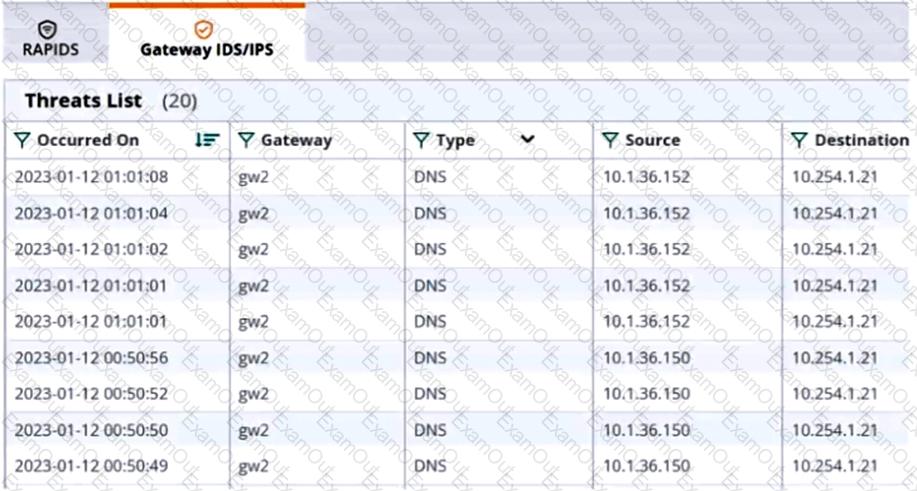
Which step could give you valuable context about the incident?
Refer to the scenario.
# Introduction to the customer
You are helping a company add Aruba ClearPass to their network, which uses Aruba network infrastructure devices.
The company currently has a Windows domain and Windows CA. The Window CA issues certificates to domain computers, domain users, and servers such as domain controllers. An example of a certificate issued by the Windows CA is shown here.
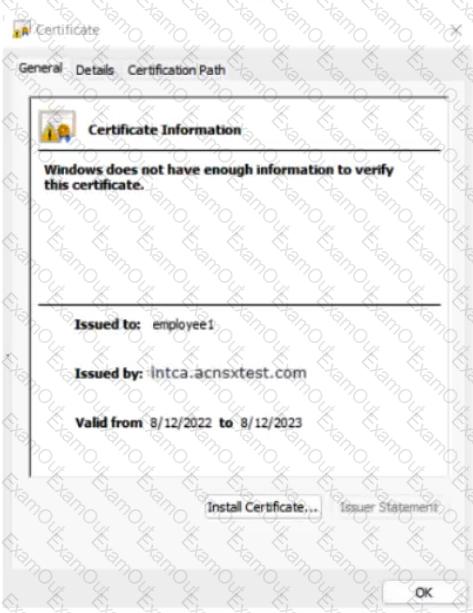
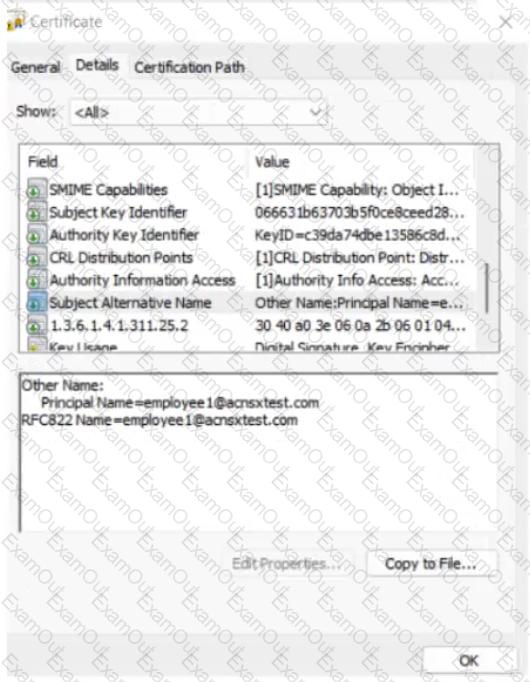
The company is in the process of adding Microsoft Endpoint Manager (Intune) to manage its mobile clients. The customer is maintaining the on-prem AD for now and uses Azure AD Connect to sync with Azure AD.
# Requirements for issuing certificates to mobile clients
The company wants to use ClearPass Onboard to deploy certificates automatically to mobile clients enrolled in Intune. During this process, Onboard should communicate with Azure AD to validate the clients. High availability should also be provided for this scenario; in other words, clients should be able to get certificates from Subscriber 2 if Subscriber 1 is down.
The Intune admins intend to create certificate profiles that include a UPN SAN with the UPN of the user who enrolled the device.
# Requirements for authenticating clients
The customer requires all types of clients to connect and authenticate on the same corporate SSID.
The company wants CPPM to use these authentication methods:
 EAP-TLS to authenticate users on mobile clients registered in Intune
EAP-TLS to authenticate users on mobile clients registered in Intune
 TEAR, with EAP-TLS as the inner method to authenticate Windows domain computers and the users on them
TEAR, with EAP-TLS as the inner method to authenticate Windows domain computers and the users on them
To succeed, EAP-TLS (standalone or as a TEAP method) clients must meet these requirements:
 Their certificate is valid and is not revoked, as validated by OCSP
Their certificate is valid and is not revoked, as validated by OCSP
 The client’s username matches an account in AD
The client’s username matches an account in AD
# Requirements for assigning clients to roles
After authentication, the customer wants the CPPM to assign clients to ClearPass roles based on the following rules:
 Clients with certificates issued by Onboard are assigned the “mobile-onboarded” role
Clients with certificates issued by Onboard are assigned the “mobile-onboarded” role
 Clients that have passed TEAP Method 1 are assigned the “domain-computer” role
Clients that have passed TEAP Method 1 are assigned the “domain-computer” role
 Clients in the AD group “Medical” are assigned the “medical-staff” role
Clients in the AD group “Medical” are assigned the “medical-staff” role
 Clients in the AD group “Reception” are assigned to the “reception-staff” role
Clients in the AD group “Reception” are assigned to the “reception-staff” role
The customer requires CPPM to assign authenticated clients to AOS firewall roles as follows:
 Assign medical staff on mobile-onboarded clients to the “medical-mobile” firewall role
Assign medical staff on mobile-onboarded clients to the “medical-mobile” firewall role
 Assign other mobile-onboarded clients to the “mobile-other” firewall role
Assign other mobile-onboarded clients to the “mobile-other” firewall role
 Assign medical staff on domain computers to the “medical-domain” firewall role
Assign medical staff on domain computers to the “medical-domain” firewall role
 All reception staff on domain computers to the “reception-domain” firewall role
All reception staff on domain computers to the “reception-domain” firewall role
 All domain computers with no valid user logged in to the “computer-only” firewall role
All domain computers with no valid user logged in to the “computer-only” firewall role
 Deny other clients access
Deny other clients access
# Other requirements
Communications between ClearPass servers and on-prem AD domain controllers must be encrypted.
# Network topology
For the network infrastructure, this customer has Aruba APs and Aruba gateways, which are managed by Central. APs use tunneled WLANs, which tunnel traffic to the gateway cluster. The customer also has AOS-CX switches that are not managed by Central at this point.
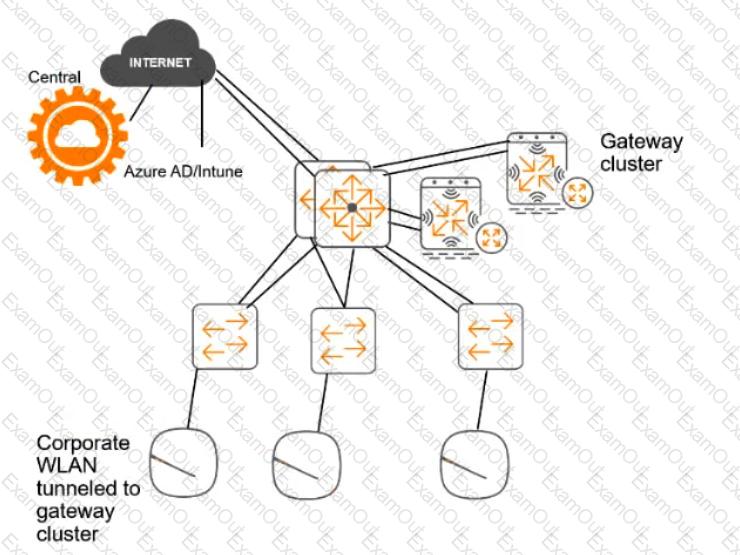
# ClearPass cluster IP addressing and hostnames
A customer’s ClearPass cluster has these IP addresses:
 Publisher = 10.47.47.5
Publisher = 10.47.47.5
 Subscriber 1 = 10.47.47.6
Subscriber 1 = 10.47.47.6
 Subscriber 2 = 10.47.47.7
Subscriber 2 = 10.47.47.7
 Virtual IP with Subscriber 1 and Subscriber 2 = 10.47.47.8
Virtual IP with Subscriber 1 and Subscriber 2 = 10.47.47.8
The customer’s DNS server has these entries
 cp.acnsxtest.com = 10.47.47.5
cp.acnsxtest.com = 10.47.47.5
 cps1.acnsxtest.com = 10.47.47.6
cps1.acnsxtest.com = 10.47.47.6
 cps2.acnsxtest.com = 10.47.47.7
cps2.acnsxtest.com = 10.47.47.7
 radius.acnsxtest.com = 10.47.47.8
radius.acnsxtest.com = 10.47.47.8
 onboard.acnsxtest.com = 10.47.47.8
onboard.acnsxtest.com = 10.47.47.8
You have imported the root certificate for the Windows CA to the ClearPass CA Trust list.
Which usages should you add to it based on the scenario requirements?
Refer to the scenario.
# Introduction to the customer
You are helping a company add Aruba ClearPass to their network, which uses Aruba network infrastructure devices.
The company currently has a Windows domain and Windows CA. The Window CA issues certificates to domain computers, domain users, and servers such as domain controllers. An example of a certificate issued by the Windows CA is shown here.
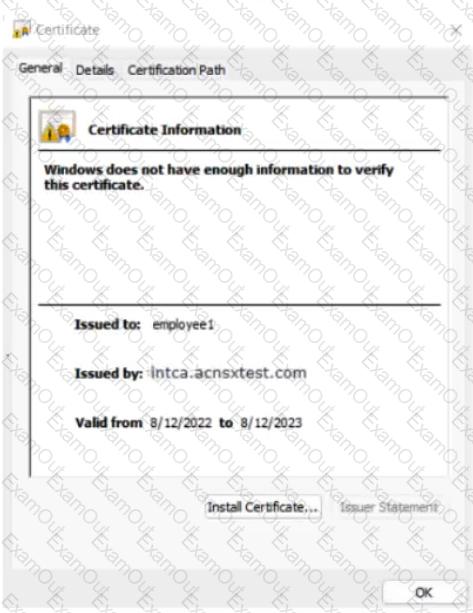
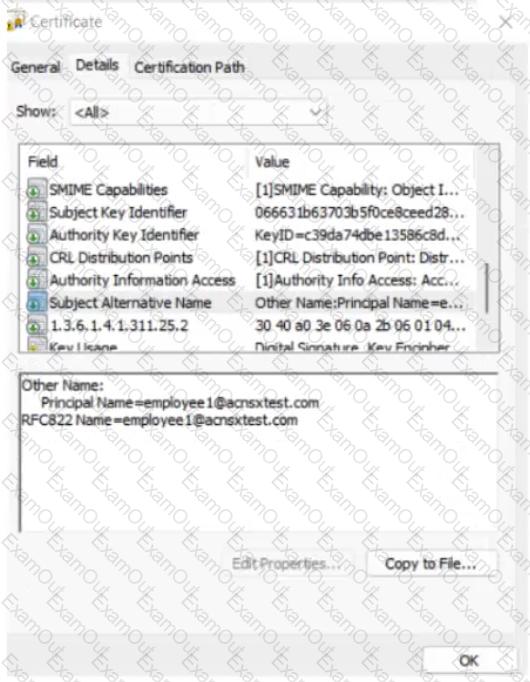
The company is in the process of adding Microsoft Endpoint Manager (Intune) to manage its mobile clients. The customer is maintaining the on-prem AD for now and uses Azure AD Connect to sync with Azure AD.
# Requirements for issuing certificates to mobile clients
The company wants to use ClearPass Onboard to deploy certificates automatically to mobile clients enrolled in Intune. During this process, Onboard should communicate with Azure AD to validate the clients. High availability should also be provided for this scenario; in other words, clients should be able to get certificates from Subscriber 2 if Subscriber 1 is down.
The Intune admins intend to create certificate profiles that include a UPN SAN with the UPN of the user who enrolled the device.
# Requirements for authenticating clients
The customer requires all types of clients to connect and authenticate on the same corporate SSID.
The company wants CPPM to use these authentication methods:
 EAP-TLS to authenticate users on mobile clients registered in Intune
EAP-TLS to authenticate users on mobile clients registered in Intune
 TEAR, with EAP-TLS as the inner method to authenticate Windows domain computers and the users on them
TEAR, with EAP-TLS as the inner method to authenticate Windows domain computers and the users on them
To succeed, EAP-TLS (standalone or as a TEAP method) clients must meet these requirements:
 Their certificate is valid and is not revoked, as validated by OCSP
Their certificate is valid and is not revoked, as validated by OCSP
 The client’s username matches an account in AD
The client’s username matches an account in AD
# Requirements for assigning clients to roles
After authentication, the customer wants the CPPM to assign clients to ClearPass roles based on the following rules:
 Clients with certificates issued by Onboard are assigned the “mobile-onboarded” role
Clients with certificates issued by Onboard are assigned the “mobile-onboarded” role
 Clients that have passed TEAP Method 1 are assigned the “domain-computer” role
Clients that have passed TEAP Method 1 are assigned the “domain-computer” role
 Clients in the AD group “Medical” are assigned the “medical-staff” role
Clients in the AD group “Medical” are assigned the “medical-staff” role
 Clients in the AD group “Reception” are assigned to the “reception-staff” role
Clients in the AD group “Reception” are assigned to the “reception-staff” role
The customer requires CPPM to assign authenticated clients to AOS firewall roles as follows:
 Assign medical staff on mobile-onboarded clients to the “medical-mobile” firewall role
Assign medical staff on mobile-onboarded clients to the “medical-mobile” firewall role
 Assign other mobile-onboarded clients to the “mobile-other” firewall role
Assign other mobile-onboarded clients to the “mobile-other” firewall role
 Assign medical staff on domain computers to the “medical-domain” firewall role
Assign medical staff on domain computers to the “medical-domain” firewall role
 All reception staff on domain computers to the “reception-domain” firewall role
All reception staff on domain computers to the “reception-domain” firewall role
 All domain computers with no valid user logged in to the “computer-only” firewall role
All domain computers with no valid user logged in to the “computer-only” firewall role
 Deny other clients access
Deny other clients access
# Other requirements
Communications between ClearPass servers and on-prem AD domain controllers must be encrypted.
# Network topology
For the network infrastructure, this customer has Aruba APs and Aruba gateways, which are managed by Central. APs use tunneled WLANs, which tunnel traffic to the gateway cluster. The customer also has AOS-CX switches that are not managed by Central at this point.
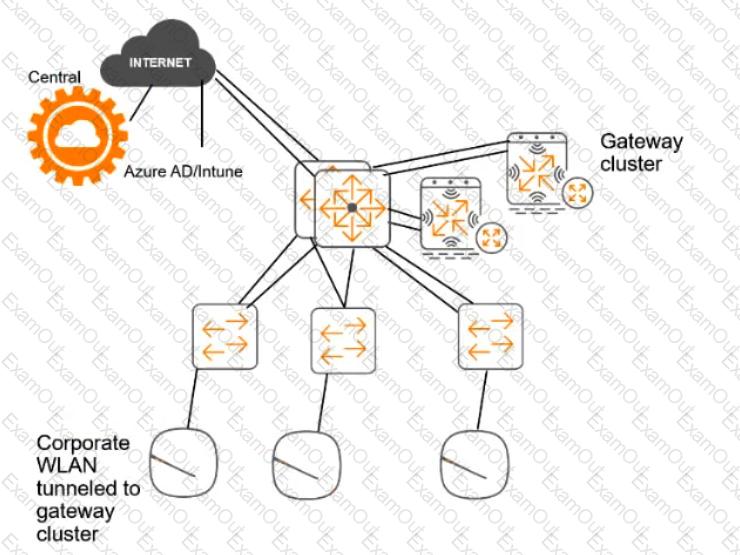
# ClearPass cluster IP addressing and hostnames
A customer’s ClearPass cluster has these IP addresses:
 Publisher = 10.47.47.5
Publisher = 10.47.47.5
 Subscriber 1 = 10.47.47.6
Subscriber 1 = 10.47.47.6
 Subscriber 2 = 10.47.47.7
Subscriber 2 = 10.47.47.7
 Virtual IP with Subscriber 1 and Subscriber 2 = 10.47.47.8
Virtual IP with Subscriber 1 and Subscriber 2 = 10.47.47.8
The customer’s DNS server has these entries
 cp.acnsxtest.com = 10.47.47.5
cp.acnsxtest.com = 10.47.47.5
 cps1.acnsxtest.com = 10.47.47.6
cps1.acnsxtest.com = 10.47.47.6
 cps2.acnsxtest.com = 10.47.47.7
cps2.acnsxtest.com = 10.47.47.7
 radius.acnsxtest.com = 10.47.47.8
radius.acnsxtest.com = 10.47.47.8
 onboard.acnsxtest.com = 10.47.47.8
onboard.acnsxtest.com = 10.47.47.8
The customer needs a secure way for users to enroll their new wireless clients in Intune. You are recommending a new WLAN that will provide the users with limited access for the enrollment.
You have set up captive portal for clients on this WLAN to a web page with instructions for enrolling devices. You will need to add several hostnames to the captive portal allowlist manually.
What is one of those hostnames?
Several AOS-CX switches are responding to SNMPv2 GET requests for the public community. The customer only permits SNMPv3. You have asked a network admin to fix this problem. The admin says, “I tried to remove the community, but the CLI output an error.”
What should you recommend to remediate the vulnerability and meet the customer’s requirements?
You are setting up Aruba ClearPass Policy Manager (CPPM) to enforce EAP-TLS authentication with Active Directory as the authentication source. The company wants to prevent users with disabled accounts from connecting even if those users still have valid certificates.
As the first part of meeting these criteria, what should you do to enable CPPM to determine where accounts are enabled in AD or not?
Refer to the scenario.
A customer has an AOS10 architecture that is managed by Aruba Central. Aruba infrastructure devices authenticate clients to an Aruba ClearPass cluster.
In Aruba Central, you are examining network traffic flows on a wireless IoT device that is categorized as “Raspberry Pi” clients. You see SSH traffic. You then check several more wireless IoT clients and see that they are sending SSH also.
You want a relatively easy way to communicate the information that an IoT client has used SSH to Aruba CPPM.
What is one prerequisite?
Refer to the scenario.
A customer has an Aruba ClearPass cluster. The customer has AOS-CX switches that implement 802.1X authentication to ClearPass Policy Manager (CPPM).
Switches are using local port-access policies.
The customer wants to start tunneling wired clients that pass user authentication only to an Aruba gateway cluster. The gateway cluster should assign these clients to the “eth-internet" role. The gateway should also handle assigning clients to their VLAN, which is VLAN 20.
The plan for the enforcement policy and profiles is shown below:
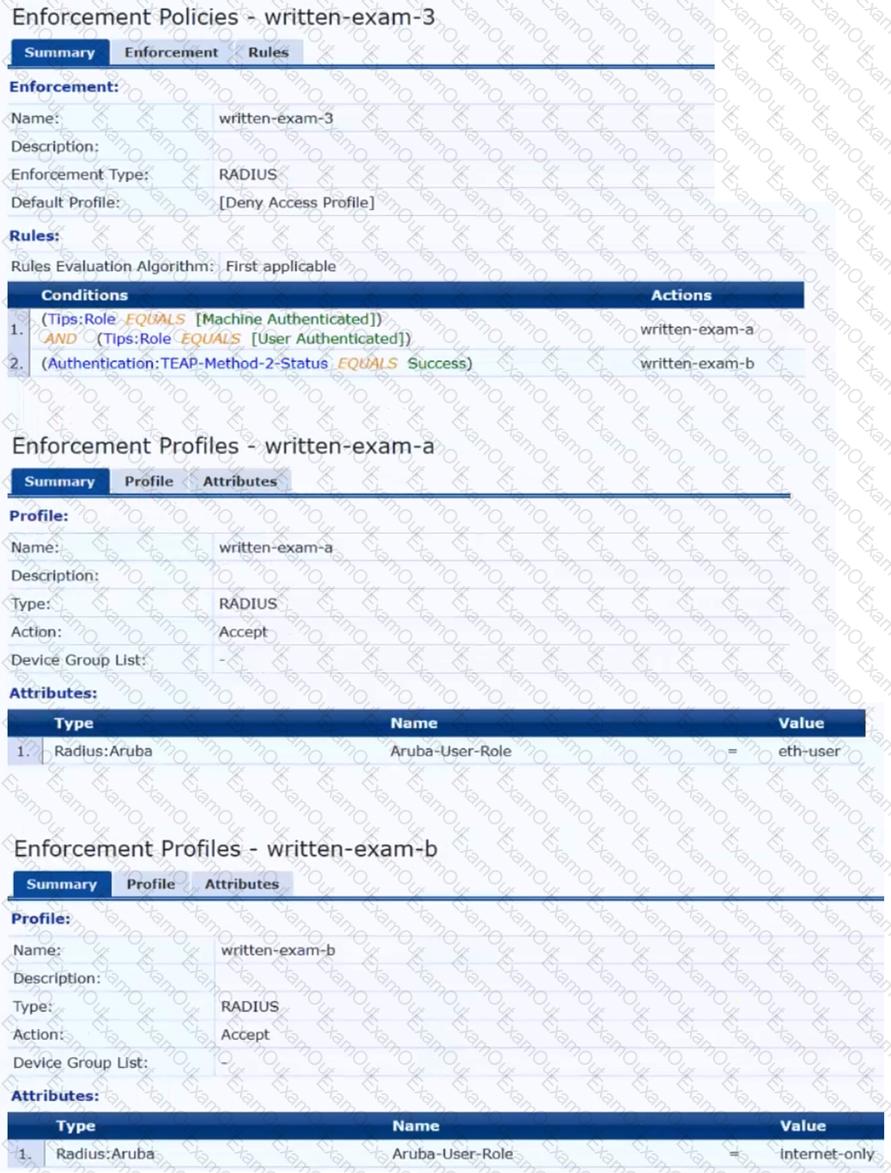
The gateway cluster has two gateways with these IP addresses:
• Gateway 1
o VLAN 4085 (system IP) = 10.20.4.21
o VLAN 20 (users) = 10.20.20.1
o VLAN 4094 (WAN) = 198.51.100.14
• Gateway 2
o VLAN 4085 (system IP) = 10.20.4.22
o VLAN 20 (users) = 10.20.20.2
o VLAN 4094 (WAN) = 198.51.100.12
• VRRP on VLAN 20 = 10.20.20.254
The customer requires high availability for the tunnels between the switches and the gateway cluster. If one gateway falls, the other gateway should take over its tunnels. Also, the switch should be able to discover the gateway cluster regardless of whether one of the gateways is in the cluster.
What is one change that you should make to the solution?
You are reviewing an endpoint entry in ClearPass Policy Manager (CPPM) Endpoints Repository.
What is a good sign that someone has been trying to gain unauthorized access to the network?
A customer has an AOS 10 architecture, which includes Aruba APs. Admins have recently enabled WIDS at the high level. They also enabled alerts and email notifications for several events, as shown in the exhibit.

Admins are complaining that they are getting so many emails that they have to ignore them, so they are going to turn off all notifications.
What is one step you could recommend trying first?
A customer has an AOS 10-based solution, including Aruba APs. The customer wants to use Cloud Auth to authenticate non-802.1X capable IoT devices.
What is a prerequisite for setting up the device role mappings?

